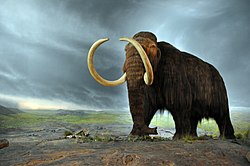User:Globgogabgalab33321/sandbox


The geologic record of the British city of Wolverhampton extends back approximately 420 million years ago to the Silurian period, before which time the city's landmass was likely submerged under water. The city's earliest fossil record includes trilobites, brachiopods and corals. Wolverhampton was probably underwater Mesozoic era. Fossils from this period include ammonites and other sea life from that time. During the Cenozoic, Wolverhampton's climate gradually became icy during the Ice Age and eventually yielded the environments now found in the city. The era's fossils include wooly mammoths, wooly rhinos, cave lions, saber-toothed tigers and possibly early Homo fossils.
The Silurian trilobite Calymene blumenbachii is the Wolverhampton (and Dudley) city fossil.
Prehistory
[edit]Precambrian eon
[edit]There are no known rocks in Wolverhampton from the Precambrian eon. Geologists infer that the area now occupied by Wolverhampton must have been submerged very deep (over 2250 ft deep) on the ocean floor during that eon. Also, geologists infer that the rocks making up the Yam Yam Precambrian seabed were probably not sedimentary rocks.
Paleozoic era
[edit]Wolverhampton's oldest rocks are located at Wren's Nest in Dudley. These are about 420 million years ago, and date back to the Late Silurian era. These deposits include trilobites as well as extinct corals and brachiopods, indicating a shallow marine environment. Most of Wolverhampton would remain under water until the Cenozoic era.

Many pockets of Permian aged rocks can be found in Wolverhampton (most notably Haffield Breccia). These areas were probably mostly underwater, as no land-based fossils have been found there.
Mesozoic era
[edit]Wolverhampton remained covered by shallow seaways throughout the Mesozoic era.
Many rocks within the Sherwood Sandstone Group date back to the Early Triassic, about 250 - 245 million years ago. These rocks are far too old for dinosaur fossils.
One formation in particular, the Kidderminster Formation, was formed in Kidderminster about 245 - 228 million years ago, leaving the possibility for dinosaur fossils to have formed. As of 2018, less than fifteen dinosaur fossils have been found in Wolverhampton, although they have been found in neighbouring parts of the West Midlands, such as Cruxicheiros and Cetiosaurus, which were both found in Warwickshire. This indidaces that wolverhampton may have been a hot, tropical environment for dinosaurs to thrive in.

Some Mezozoic fossils include ammonites and other sea life.
Cenozoic era
[edit]Pleistocene-aged fossils include wooly mammoths, wooly rhinos, cave lions, saber-toothed tigers and possibly early Homo fossils. Most of these species went extinct due to climate change.


